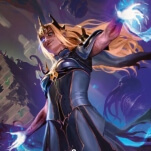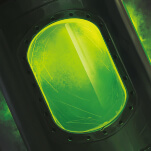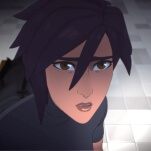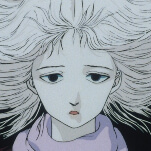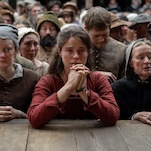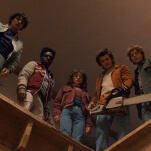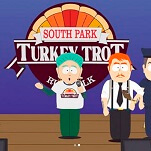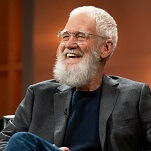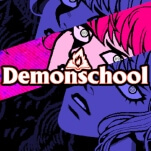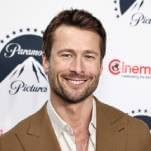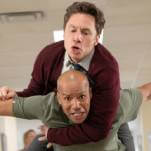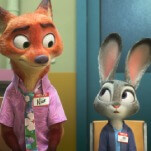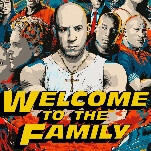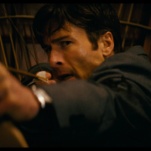The Forgotten Realms are the current spine of Dungeons & Dragons as a commercial product. The roleplaying that people love, with all its ups and downs, is positioned by Wizards Of The Coast as happening near, through, or within the Realms, a fantastical world of varied biomes and peoples. If you want to adventure with the official books that D&D offers, you’re going to hear about the Realms; if you want to play Baldur’s Gate 3, you’re going to hang out in the Realms; if you’re going to read official fiction, it’s more than likely going to be something about the Realms. As a space and a set of expectations, the Forgotten Realms exert a lot of influence, so it is not surprise that this fall’s two big Dungeons & Dragons supplements, Heroes Of Faerûn and Adventures In Faerûn, are expansive engagements with a place that the product line works at like a bad tooth.
The real question, then, is if this constant return to the Forgotten Realms is worth the squeeze. Using the basic rules of D&D, you can play anywhere—you can create your own fantasy world, you can pull from published adventures by other companies, or you could even set a game in your own town. The nature of roleplaying games is that they are fantastically flexible, and unless you’re one of the players who believes that WOTC determines all of your possible fun (in which case I am deeply sorry for you), you have the ability to take the basic framework of the game and apply it to anything your imagination can summon. I think that, generally, the Forgotten Realms books need to provide a positive case of themselves. I think they need to convince you, or at least me, that this fantasy world is something that is pleasurable and fun for reasons beyond pure corporate inertia.
The two books, henceforth Adventures and Heroes, notionally cover two different areas. Adventures is a book that faces Dungeon Masters, the players who are responsible for running the game. It is full of places and things that happen in those places. When you string those events together, we call them an adventure, and players enjoy doing them if you play them right. Adventures centers on trying to give those DMs the context and tools to situate and execute adventures in the Forgotten Realms so that everyone can have a good gaming night.
At least conceptually, Heroes takes another approach, offering players the ability to customize and distinguish their characters from ones that they might have played in other games. This book offers a huge number of options for grounding the character classes of D&D in the Realms and the cultures and places that are unique to that setting. Each species that you can play as is offered a little bit of lore attaching them to the Realms (elves here call themselves tel’quessir; halflings who form permanent communities become stronghearts), and several of the classes in the game get Forgotten Realms-specific options (paladins from Calimshan can align with genies; rogues can specialize in loving the Dead Three from Baldur’s Gate 3).
While the big picture is that these are two books that take two pretty different approaches to speak to two different audiences within the Dungeons & Dragons playerbase, the reality is that there is a massive amount of crossover material to be found in the two books. This isn’t a shock, given that they are both about giving context to very specific places in a particular setting, and a lot of that context is relevant both to Dungeon Masters and player characters who are interacting with what the Dungeon Master is presenting them with. Whatever the reason, about 70 pages of Heroes is dedicated to the gods and factions of the Realms in a purely descriptive sense, telling us about them and their desires, meaning that a third of the book is context for play but not really directly related to it. In previous D&D materials, this would be considered prime DM material.
The fact of it is that Faerûn shines because it is a compelling setting, and reading the two books back to back reveals a depth in Adventures that I just do not see in Heroes. The former book is a very careful document, cycling through five of the major regions of the Forgotten Realms and walking DMs through the events, peoples, and adventures that might take place there. I am a long-running Forgotten Realms enjoyer, whatever its faults as a setting, and these sections are both readable and informative, patiently telling Dungeon Masters what they might want to know in order to make this place feel like a living world with reasonably real people.
There is also an active effort to make the different regions of the Realms feel distinctive from one another in geography and genre, and this feels like a new move in WOTC’s description of this place. The Forgotten Realms have always had a tinge of cultural tourism about them, to put it lightly: there’s a fantasy Europe, a fantasy Middle East, a fantasy China, and so on, and these adaptations of real-world cultures into the Realms setting have historically felt appropriative and insensitive to many players. Adventures dodges some of this by sticking to the continent of Faerûn entirely and so avoiding regions like Kara-Tur (seen most famously in Oriental Adventures from the mid-1980s) and also by taking seriously the development of locations like Calimsham, which began its existence as a fantastical generic Middle Eastern setting and has developed into a substantive location of magic and intrigue over the past few decades of Faerûnian transformation.
Part of that transformation that is pushed even further here is that the D&D team positions each of the regions in Adventures as the sites for particular kinds of adventures. Icewind Dale, the cold northern region full of monsters, barbarians, and far-flung settlements, is characterized in this book as a place for folk horror and dark fantasy adventures that depend on isolation and desperation. The Dalelands, a forest-and-meadows region, is cast as a generic fantasy location for genre standards to come into play—wizard towers and creepy tombs threaten hearty farm folk. The book specifically calls out “eco-fantasy” as a resonant term for the Moonshae Isles, a locale that has historically been associated with misty moors and fairy magic in the Forgotten Realms, and gives several examples of how different kinds of magic interact with each other there. This is quite different from other D&D books in terms of scope and scale, and I hope the company keeps making books like this one that speak to players about how they might access certain genres using particular pieces of their prepared fictional worlds.
Looming above any of my particular opinions about these books is the fact that both feel like they are built to be dismantled. Both Adventures and Heroes have the feeling of being carved into discrete pieces to be plugged into D&D Beyond, the digital roleplaying platform that Wizards has leaned into significantly over the past few years. Much of the player-facing material from Heroes seems built for the character-creator system in Beyond, and most of the prepared adventures in Adventures are single- or half-page setups with maps that can be easily run from that system. The sheer amount of short, staccato material that is in these books generates the feeling of looking at a vast database rather than a traditional book for Dungeons & Dragons, and it is hard for me to shake the feeling that these books are the product of Wizards Of The Coast learning from the vast proliferation of third-party materials on platforms like Dungeon Masters Guild. These materials exist to give players more options, get DMs up and running faster, and generally facilitate a sense of there being always-more-stuff.
That’s the vibe of these books, and it feels like a slope downward toward something that I am less interested in, but the high points of Adventures in Faerûn, which is the much more impressive book, do at least legitimize the release of these things. Adventures has a series of perspectives on the world, and it asks players and Dungeon Masters to think about what kind of genre experiences they want in this particular sandbox, which is much more reflective than I associate with the D&D brand. Overall, I think Heroes is a big skip for most people, but Adventures now sits high on my list of “must reads” for people who are interested in Dungeons & Dragons and want to think about engaging more deeply with the Forgotten Realms tools.


